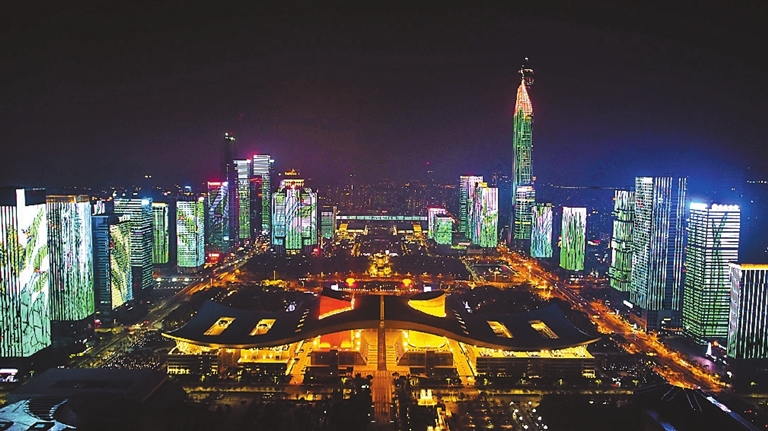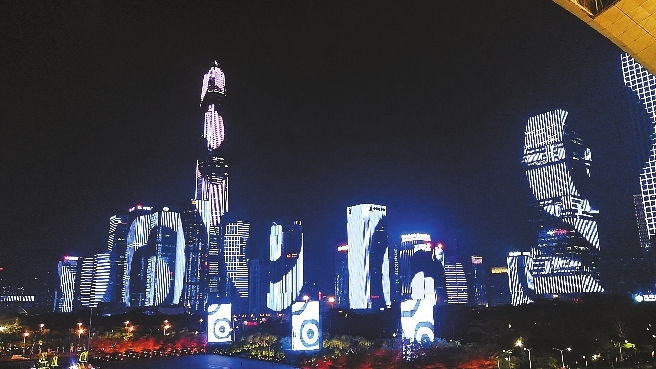

Cao Zhen caozhen0806@126.com A NEW light show generated by AI algorithms will open the 2019 Bi-city Biennale of UrbanismArchitecture (UABB) in Futian District in Shenzhen on the night of Dec. 21, Shenzhen City of Design Promotion Association (SDPA) New Media Public Art Committee announced at a forum titled “Reviewing the Lights of the City” on Sunday. Award-winning light works from the 2019 UABB (Shenzhen) Light Show and Urban Light Art Museum Creative Design Competition will bathe 43 tall buildings and the open public space surrounding the Civic Center in central Futian. The competition was held from August to October, aiming to turn the light show into a new media public art exhibition and enhance Shenzhen’s image as a chic, vibrant and innovative metropolis. “Among the 35 entries the competition received from home and abroad, we found most works are generated by algorithms and favored by our judges,” said Chen Xiaohan, secretary-general of the SDPA New Media Public Art Committee. No more details on the new light show have been announced. Polish music and audiovisual producer Dariusz Makaruk, who won first prize in the competition, introduced his past light projects at Sunday’s forum held at Shenzhen Museum of Contemporary Art and Urban Planning. His works are distinctive for the participation of performers and audience members who can manipulate the content via gestures or movements. “What you see is easy to be forgotten but when what you actually do becomes part of a work, you will not forget it,” he said. U.S. multimedia artist, designer and musician Simon Alexander-Adams, who won third prize in the competition, specializes in real-time generative art, interactive installations and audiovisual performances. “My philosophy is that interaction should be easy to grasp with no instructions required, but it should have the potential to allow users to develop skills — in short: low floor, high ceiling,” he said. Since last year, two versions of light shows (themed “Glorious New Era” and “Vibrant City”) have been held on the facades of the 43 high buildings in central Futian. “Glorious New Era” mainly uses strong colors to celebrate the 70th birthday of the motherland and the 40th anniversary of reform and opening up and showcases Shenzhen’s open, inclusive and innovative spirit. In “Vibrant City,” artists Shen Shaomin, Mulga (Joel Moore), Reko Rennie and Beau McClellan were invited to use geometric figures, icons and child-friendly art to create a refreshing and playful light show. The two versions have become not only a weekend hangout event for locals and travelers but also the talk of the town. Sunday’s forum, hosted by the SDPA, organized by the SDPA New Media Public Art Committee and jointly planned by ARTDBL, was held to spark ideas from architects and artists on the upcoming new light show. As Chinese Academy of Engineering academician, 2019 UABB (Shenzhen) chief curator and the SDPA’s president Meng Jianmin put it, discussing a light show should not be limited to performing but focus on urban design and a city’s humanistic value. “Our cities are bright enough at night but lack warmth, so we hope artists can bring a feeling of warmth through their works,” said artist Shen Shaomin, who is the chief director of the “Vibrant City” light show. “The 43 buildings in Futian present the world’s grandest interface for light display. I hope artists will not use the giant facade as a TV screen but render their unique light artworks.” Architect Liu Xiaodu, who is URBANUS co-founder, director of Pingshan Art Museum and chief artistic advisor of the competition, agreed that artists should use new media and technologies to express contemporary art ideas and present Shenzhen’s unique style. “It’s generally accepted that the art of light forms a part of urban culture and contributes to modern cities’ night economy development. Flaunting is not the goal of a light show, and creations should be focused on a city’s concept and content,” said Liu. Zhang Yuxing, initiator of the UABB and director of the UABB Academic Committee, believes that in today’s world, light is information. “In ancient times, light related to fire and living; now TVs and mobile phones are also luminous objects, and the core of light has become information. I hope in light shows, lights can convey quality information,” he said. As for the issue of light pollution, experts agreed that human comfort should be considered when creating and scheduling light shows. Some architects also discussed whether light shows will have a positive or negative impact on the future of architectural design. Themed “Urban Interactions,” the 2019 UABB (Shenzhen) will be held from December to March at Futian Station, Shenzhen Museum of Contemporary Art and Urban Planning, and eight subvenues across the city. The current light shows are held at 7 p.m. (“Glorious New Era”) and 8 p.m. (“Vibrant City”) every Friday and Saturday in central Futian. | 
